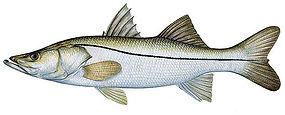
WHAT WE CATCH



Here's an idea of what we specialize in:

REDFISH
Redfish are one of many game fish to catch along the Gulf Coast. These fish invade the shallows flats for safety until maturity. They can often be found in the same places as snook, trout and a host of other flats gamefish. As they grow, they eventually move offshore to join with the larger fish. Even though they are small compared to their seniors, they still are great tackle busters on light tackle. They range from 20 to 35 inches and there is incredible redfish fishing all over Estero Bay and the surrounding areas.

SNOOK
Snook are found from central Florida south, usually inshore in coastal and brackish waters. They are also common along mangrove shorelines, seawalls, and bridges. Snook are also on reefs and around pilings nearshore. They congregate in large schools during summer in deep passes and inlets to spawn. Snook begin life as males, but between 18 and 22 inches long some become females. They orient themselves to face moving water and wait for prey to be carried down the current. Snook jump clear of the water, and burst into long runs..

TARPON
Tarpon have a distinctive dorsal fin ray that extends into a long filament, a large upward pointing mouth and very large scales. They tolerate a wide salinity range, and as juveniles, enter fresh waters. Tarpon can gulp air and remove oxygen by means of lung-like tissue near their swim bladder. This "rolling" effect is one way to spot tarpon. We catch tarpon that weigh 50 to 175 pounds on average. Tarpon season is a fun time! If you like a thrill, just wait until you're hooked up.


